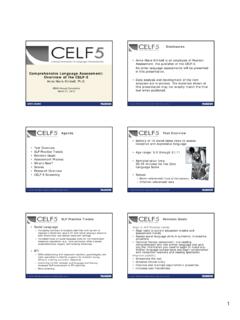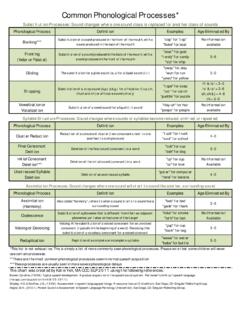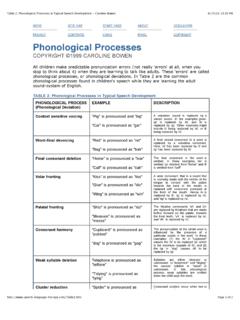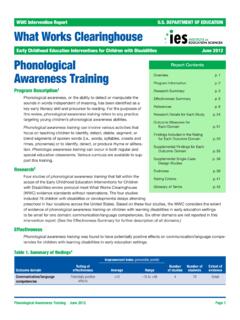Transcription of Assessment of Articulation and Phonological Processing ...
1 Assessment of Articulation and Phonological Processing Using the GFTA-3 and KLPA-3 Gloria Maccow, , Assessment Training ConsultantCopyright 2015. Pearson, Inc., and/or its affiliates. All rights reserved. 1 Assessment of Articulation and Phonological Processing Using the GFTA-3 and KLPA-3 Gloria Maccow, , 2016 Assessing Articulation and Phonological Processing | 2 Disclosures Gloria Maccow, is employed by Pearson Clinical Assessment , publisher of the GFTA-3 and KLPA-3. This presentation will focus on administration, scoring, and interpretation of the GFTA-3 and KLPA-3. No other Articulation or Phonological assessments will be discussed during this Articulation and Phonological Processing | 3 Learning Objectives Describe at least three features new to the GFTA-3 and KLPA-3.
2 Identify at least two changes to the scoring procedures for the GFTA-3. List at least two factors to consider when evaluating an examinee s error patterns on the GFTA-3 and of Articulation and Phonological Processing Using the GFTA-3 and KLPA-3 Gloria Maccow, , Assessment Training ConsultantCopyright 2015. Pearson, Inc., and/or its affiliates. All rights reserved. 2 Assessing Articulation and Phonological Processing | 4 ArticulationPhonological ProcessesSpeech Sound Articulation and Phonological Processing | 5 How are Speech Sound Disorders Diagnosed?Listen to Person SpeakUse Formal Articulation TestConduct Oral Mechanism ExamEvaluate Language DevelopmentAssessing Articulation and Phonological Processing | 6 The new Goldman-Fristoe Test of Articulation Third Edition (GFTA -3) and Khan-Lewis Phonological Analysis Third Edition (KLPA -3) offer comprehensive Articulation and phonology Assessment designed to help you diagnose speech sound disorders and plan effective intervention for your diverse client of Articulation and Phonological Processing Using the GFTA-3 and KLPA-3 Gloria Maccow, , Assessment Training ConsultantCopyright 2015.
3 Pearson, Inc., and/or its affiliates. All rights reserved. 3 Assessing Articulation and Phonological Processing | 7 ArticulationGoldman-Fristoe Test of Articulation -3 Provides diagnostic information about individual s ability to articulate consonant sounds in single words and connected speech. PhonologyKhan-Lewis Phonological Analysis-3 Provides a comprehensive analysis of speech sound patterns so you can determine if use of Phonological processes is contributing to an individual s speech sound disorder. GFTA-3 Assessing Articulation and Phonological Processing | 9 Features of GFTA-3 Administered speech sound abilities in the area of with children, adolescents, and young adults (ages 2:0 through 21 by of Articulation and Phonological Processing Using the GFTA-3 and KLPA-3 Gloria Maccow, , Assessment Training ConsultantCopyright 2015.)
4 Pearson, Inc., and/or its affiliates. All rights reserved. 4 Assessing Articulation and Phonological Processing | 10 Test MaterialsManualStimulus BookRecord FormAssessing Articulation and Phonological Processing | 11 Comparing GFTA-3 and GFTA-2 See handoutGFTA-3 What s New? Assessment of Articulation and Phonological Processing Using the GFTA-3 and KLPA-3 Gloria Maccow, , Assessment Training ConsultantCopyright 2015. Pearson, Inc., and/or its affiliates. All rights reserved. 5 Assessing Articulation and Phonological Processing | 13 GFTA-3 Updates Multiple opportunities to produce consonant and consonant cluster sounds in different word scores for Articulation at word level and connected speech intelligibility in connected speech with that of same-age Articulation and Phonological Processing | 14 What s New?
5 Assess consonants in multiple error analyses for vowels and R scoring for a wide range of American English new sets of picture Articulation and Phonological Processing | 15 What s New?Easy-to-elicit connected speech measure with a new sentence imitation scores for speech sound productions in connected intelligibility of Articulation and Phonological Processing Using the GFTA-3 and KLPA-3 Gloria Maccow, , Assessment Training ConsultantCopyright 2015. Pearson, Inc., and/or its affiliates. All rights reserved. 6 Assessing Articulation and Phonological Processing | 16 Dialect-Sensitive ScoringIf a response to a GFTA-3 item is a variation from SAE that is appropriate for the individual s speech and language background, score it as correct. See Appendix E: common Phonemic Contrasts between Standard American English and _____Table EnglishTable EnglishTable EnglishKLPA-3 Assessing Articulation and Phonological Processing | 18 Features of KLPA-3 Companion tool for GFTA-3.
6 Norm-referenced in-depth analysis of Phonological process with children, adolescents, and young adults (ages 2:0 through 21 analyzes responses on GFTA-3 to obtain further diagnostic information about speech sound of Articulation and Phonological Processing Using the GFTA-3 and KLPA-3 Gloria Maccow, , Assessment Training ConsultantCopyright 2015. Pearson, Inc., and/or its affiliates. All rights reserved. 7 Assessing Articulation and Phonological Processing | 19 When to Complete Phonological Analysis of GFTA-3 ResultsSpeech is reasonably intelligible and contains few misarticulated is reasonably intelligible and contains many misarticulated is very young or has moderately to severely unintelligible Articulation and Phonological Processing | 20 Copyright 2015.)
7 NCS Pearson Inc. All rights reserved. Materials NeededAssessing Articulation and Phonological Processing | 21 Comparing KLPA-3 and KLPA-2 See handoutAssessment of Articulation and Phonological Processing Using the GFTA-3 and KLPA-3 Gloria Maccow, , Assessment Training ConsultantCopyright 2015. Pearson, Inc., and/or its affiliates. All rights reserved. 8 KLPA-3 What s New?Assessing Articulation and Phonological Processing | 23 New Features!More efficient and accurate Phonological processes for each sound percent of occurrence for each Phonological Articulation and Phonological Processing | 24 New to KLPA-3 Core (Developmental processes) vs. Supplemental (Atypical) Processes Core Phonological Process Analysis Percent of Occurrence of Supplemental Processes Phonological Processes per Word (PPW) Intelligibility rating Vowel analyses Phonetic inventory Vowel Phonological process usageAssessment of Articulation and Phonological Processing Using the GFTA-3 and KLPA-3 Gloria Maccow, , Assessment Training ConsultantCopyright 2015.
8 Pearson, Inc., and/or its affiliates. All rights reserved. 9 Assessing Articulation and Phonological Processing | 2512 Core ProcessesCore Processes: frequently occurring Phonological processes that are developmental in natureNew normative data. Obtain standard scores and percentile ranks by age and ReductionVoicingDeaffricationPalatal frontingCluster simplificationFinal devoicingGliding of LiquidsVelarfrontingDeletion of final consonantInitial devoicingStopping of fricatives and affricatesSyllablereductionStridencydele tionVocalizationAssessing Articulation and Phonological Processing | 26 Assessing Articulation and Phonological Processing | 2712 Supplemental ProcessesData-driven determination of the Phonological processes that are more clinical in nature (less frequently occurring.)
9 Atypical)MannerPlaceReductionVoicingAffr icationBacking to velars or /h/Deletion of initial consonantInitial devoicingFricationDeletion of medial consonantMedial devoicingGliding (Other than liquids)Medial voicingGlottal replacementLiquidizationStopping (Other than Fricatives/Affricates) Assessment of Articulation and Phonological Processing Using the GFTA-3 and KLPA-3 Gloria Maccow, , Assessment Training ConsultantCopyright 2015. Pearson, Inc., and/or its affiliates. All rights reserved. 10 Assessing Articulation and Phonological Processing | 28 Supplemental Processes The 12 Supplemental Phonological Processes are recorded, tallied and converted to a Percent of Occurrence. Generally, Supplemental Phonological Processes occur less frequently in typical development.
10 Clinical signs that could be diagnostic or prognostic and may be red flags for further consideration. Contribute to the Processes per Word (PPW).Assessing Articulation and Phonological Processing | 29 Assessing Articulation and Phonological Processing | 30 DefinitionsAssessment of Articulation and Phonological Processing Using the GFTA-3 and KLPA-3 Gloria Maccow, , Assessment Training ConsultantCopyright 2015. Pearson, Inc., and/or its affiliates. All rights reserved. 11 Assessing Articulation and Phonological Processing | 31 Phonological Processes Per Word (PPW)Assessing Articulation and Phonological Processing | 32 Other Phonological Processes and Sound Change Booklet Individuals may use Phonological processes that are not included in the Core or Supplemental Processes.








